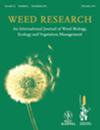Impact of regular mowing, mowing height, and grass competition on tuber number and tuber size of yellow nutsedge clonal populations (Cyperus esculentus L.)
IF 2.4
3区 农林科学
Q2 AGRONOMY
引用次数: 0
Abstract
Abstract Cyperus esculentus , a perennial sedge, is one of the most dangerous weeds in agriculture because of its high multiplication potential, its high risk of tuber spread and its low sensitivity to control measures. To diminish the risk of C. esculentus spread and incursion into adjacent crops by creeping rhizomes , control measures should also focus on non‐cropped areas adjacent to these crop zones. Defoliation by mowing is an example of one of these control measures. The aim of this study was to identify the critical mowing interval and height required for preventing tuber formation and to assess the combined effect of mowing and competition exerted by the grassy vegetation on the growth and spread of C. esculentus in field margins. In two separate years we conducted an indoor container (11 L) experiment, under a worst‐case scenario, in which genetically distinct clones, grown alone or in combination with Lolium perenne , were subjected to season‐long mowing regimes that differed in mowing interval (1‐, 2‐, 4‐ and 8‐weeks) and/or mowing height (2 and 5 cm). Weekly and 2‐weekly mowing at 5 cm within an 18‐week period significantly reduced tuber production of C. esculentus grown with competition (up to 93% and 98% reduction in tuber number respectively) and without competition from L. perenne (both a 97% reduction), compared to the uncut control with and without competition respectively. Compared to a mowing height of 5 cm, a mowing height of 2 cm resulted in better control of C. esculentus , with tuber numbers up to 32% lower and 5–65% lighter. Twice‐weekly mowing at 2 cm height can be an effective strategy for containing or reducing C. esculentus patches in field margins.定期刈割、刈割高度和禾草竞争对黄苣苔无性系群体块茎数量和块茎大小的影响
摘要莎草(Cyperus esculentus)是一种多年生莎草,由于其繁殖潜力大,块茎蔓延风险高,对防治措施的敏感性低,是农业上最危险的杂草之一。为了降低褐曲霉通过匍匐根茎向邻近作物传播和入侵的风险,防治措施还应侧重于这些种植区附近的非种植区。割草落叶就是这些控制措施之一。本研究的目的是确定防止块茎形成所需的关键割草间隔和高度,并评估割草和草地植被竞争对大田边缘柽柳生长和传播的综合影响。在不同的两年里,我们进行了一个室内容器(11l)实验,在最坏的情况下,在遗传上不同的无性系,单独生长或与多年生黑麦草结合生长,在刈割间隔(1周、2周、4周和8周)和/或刈割高度(2和5厘米)上进行了不同的刈割制度。与没有竞争和没有竞争的对照相比,在18周的时间内,每周和每2周在5厘米处割草显著减少了有竞争和没有竞争的双生草的块茎产量(分别减少了93%和98%)和块茎产量(均减少了97%)。与5 cm的刈割高度相比,2 cm的刈割高度能较好地防治黄皮草,块茎数量减少32%,块茎重量减轻5 ~ 65%。每周两次2厘米高度的刈割可以有效地控制或减少田间边缘的草斑。
本文章由计算机程序翻译,如有差异,请以英文原文为准。
求助全文
约1分钟内获得全文
求助全文
来源期刊

Weed Research
农林科学-农艺学
CiteScore
4.30
自引率
0.00%
发文量
41
审稿时长
12-24 weeks
期刊介绍:
Weed Research is an international peer-reviewed journal that publishes topical and innovative papers on weed science, in the English language. Its aim is to publish the best weed science from around the globe and to be the journal of choice for weed science researchers. It is the official journal of the European Weed Research Society. Papers are taken on all aspects of weeds, defined as plants that impact adversely on economic, aesthetic or environmental aspects of any system. Topics include, amongst others, weed biology and control, herbicides, invasive plant species in all environments, population and spatial biology, modelling, genetics, biodiversity and parasitic plants. The journal welcomes submissions on work carried out in any part of the world.
 求助内容:
求助内容: 应助结果提醒方式:
应助结果提醒方式:


